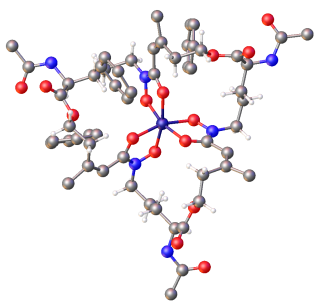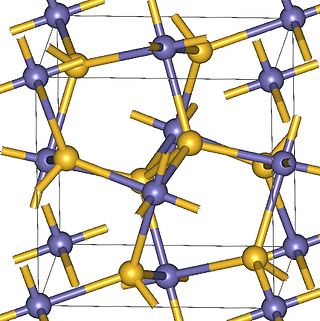Related Research Articles

Bacteriocins are proteinaceous or peptidic toxins produced by bacteria to inhibit the growth of similar or closely related bacterial strain(s). They are similar to yeast and paramecium killing factors, and are structurally, functionally, and ecologically diverse. Applications of bacteriocins are being tested to assess their application as narrow-spectrum antibiotics.

Siderophores (Greek: "iron carrier") are small, high-affinity iron-chelating compounds that are secreted by microorganisms such as bacteria and fungi. They help the organism accumulate iron. Although a widening range of siderophore functions is now being appreciated, siderophores are among the strongest (highest affinity) Fe3+ binding agents known. Phytosiderophores are siderophores produced by plants.

A conjugate vaccine is a type of subunit vaccine which combines a weak antigen with a strong antigen as a carrier so that the immune system has a stronger response to the weak antigen.

Antimicrobial peptides (AMPs), also called host defence peptides (HDPs) are part of the innate immune response found among all classes of life. Fundamental differences exist between prokaryotic and eukaryotic cells that may represent targets for antimicrobial peptides. These peptides are potent, broad spectrum antimicrobials which demonstrate potential as novel therapeutic agents. Antimicrobial peptides have been demonstrated to kill Gram negative and Gram positive bacteria, enveloped viruses, fungi and even transformed or cancerous cells. Unlike the majority of conventional antibiotics it appears that antimicrobial peptides frequently destabilize biological membranes, can form transmembrane channels, and may also have the ability to enhance immunity by functioning as immunomodulators.

Zinc peroxide (ZnO2) appears as a bright yellow powder at room temperature. It was historically used as a surgical antiseptic. More recently zinc peroxide has also been used as an oxidant in explosives and pyrotechnic mixtures. Its properties have been described as a transition between ionic and covalent peroxides. Zinc peroxide can be synthesized through the reaction of zinc chloride and hydrogen peroxide.

In organic chemistry, hydroxamic acids are a class of organic compounds having a general formula R−C(=O)−N(−OH)−R' bearing the functional group −C(=O)−N(−OH)−, where R and R' are typically organyl groups or hydrogen. They are amides wherein the nitrogen atom has a hydroxyl substituent. They are often used as metal chelators.

Enterobactin is a high affinity siderophore that acquires iron for microbial systems. It is primarily found in Gram-negative bacteria, such as Escherichia coli and Salmonella typhimurium.

Kenneth Norman Raymond is a bioinorganic and coordination chemist. He is Chancellor's Professor of Chemistry at the University of California, Berkeley, Professor of the Graduate School, the Director of the Seaborg Center in the Chemical Sciences Division at Lawrence Berkeley National Laboratory, and the President and Chairman of Lumiphore.
In chemistry, binding selectivity is defined with respect to the binding of ligands to a substrate forming a complex. Binding selectivity describes how a ligand may bind more preferentially to one receptor than another. A selectivity coefficient is the equilibrium constant for the reaction of displacement by one ligand of another ligand in a complex with the substrate. Binding selectivity is of major importance in biochemistry and in chemical separation processes.
Calprotectin is a complex of the mammalian proteins S100A8 and S100A9. Other names for calprotectin include MRP8-MRP14, calgranulin A and B, cystic fibrosis antigen, L1, 60BB antigen, and 27E10 antigen. The proteins exist as homodimers but preferentially exist as S100A8/A9 heterodimers or heterotetramers (calprotectin) with antimicrobial, proinflammatory and prothrombotic properties. In the presence of calcium, calprotectin is capable of sequestering the transition metals iron, manganese and zinc via chelation. This metal sequestration affords the complex antimicrobial properties. Calprotectin is the only known antimicrobial manganese sequestration protein complex. Calprotectin comprises as much as 60% of the soluble protein content of the cytosol of a neutrophil, and it is secreted by an unknown mechanism during inflammation. Faecal calprotectin has been used to detect intestinal inflammation and can serve as a biomarker for inflammatory bowel diseases. Blood-based calprotectin is used in diagnostics of multiple inflammatory diseases, including autoimmune diseases, like arthritis, and severe infections including sepsis.
Many bacteria secrete small iron-binding molecules called siderophores, which bind strongly to ferric ions. FepA is an integral bacterial outer membrane porin protein that belongs to outer membrane receptor family and provides the active transport of iron bound by the siderophore enterobactin from the extracellular space, into the periplasm of Gram-negative bacteria. FepA has also been shown to transport vitamin B12, and colicins B and D as well. This protein belongs to family of ligand-gated protein channels.
Guillermo Carlos Bazan is an American chemist, material scientist, and academic.

Small molecule sensors are an effective way to detect the presence of metal ions in solution. Although many types exist, most small molecule sensors comprise a subunit that selectively binds to a metal that in turn induces a change in a fluorescent subunit. This change can be observed in the small molecule sensor's spectrum, which can be monitored using a detection system such as a microscope or a photodiode. Different probes exist for a variety of applications, each with different dissociation constants with respect to a particular metal, different fluorescent properties, and sensitivities. They show great promise as a way to probe biological processes by monitoring metal ions at low concentrations in biological systems. Since they are by definition small and often capable of entering biological systems, they are conducive to many applications for which other more traditional bio-sensing are less effective or not suitable.

Rothia is a Gram-positive, aerobic, rod-shaped and non-motile bacterial genus from the family Micrococcaceae. Rothia bacteria can cause disease in humans and immunosuppressed humans.

Rebecca Abergel is a professor of nuclear engineering and of chemistry at University of California, Berkeley. Abergel is also a senior faculty scientist in the chemical sciences division of Lawrence Berkeley National Laboratory, where she directs the Glenn T. Seaborg Center and leads the Heavy Element Chemistry research group. She is the recipient of several awards for her research in nuclear and inorganic chemistry.
Munia Ganguli is an Indian biochemist, biotechnologist and a scientist at the Institute of Genomics and Integrative Biology (IGIB). She is known for the development of non-invasive protocols of drug delivery and the team led by her was successful in developing a drug delivery system for skin disorders, using a nanometer-sized peptide complex carrying plasmid DNA which has since shown effective penetration and apparently without harming the skin. She holds two patents for the processes she has developed. At IGIB, she has established her laboratory where she hosts several research scholars and scientists. Her studies have been documented by way of a number of articles and ResearchGate, an online repository of scientific articles has listed 76 of them.
Daniel Antonio Tordera Salvador is a Spanish chemist, material scientist and writer. He is currently an Assistant Professor in the Physical Chemistry Department at the University of Valencia.

Cefiderocol, sold under the brand name Fetroja among others, is an antibiotic used to treat complicated urinary tract infections when no other options are available. It is indicated for the treatment of multi-drug-resistant Gram-negative bacteria including Pseudomonas aeruginosa. It is given by injection into a vein.
Deborah Beth Zamble was a Canadian chemist and Canada Research Chair in Biological Chemistry at the University of Toronto. Her research considered how bacteria processed metal nutrients.
Jason Kelby Sello is an American chemist who is a professor of chemistry at Brown University. His research looks to develop antibacterial agents and technologies for bioenergy. In 2020, he was named by Cell Press as one of 1000 inspiring Black scientists in America.
References
- 1 2 3 4 5 6 7 "Elizabeth M. Nolan". web.mit.edu. Retrieved 2018-12-23.
- 1 2 "Smith Scholars With Places to Go". www.smith.edu. Retrieved 2018-12-23.
- 1 2 "Chemistry in Action: Liz Nolan | MIT OpenCourseWare | Free Online Course Materials". mit.uvt.rnu.tn. Retrieved 2018-12-24.
- 1 2 Ghosh, Abhik (2011-04-04). Letters to a Young Chemist. John Wiley & Sons. ISBN 978-1-118-00708-2.
- ↑ Nolan, Elizabeth M.; Lippard, Stephen J. (2009). "Small-Molecule Fluorescent Sensors for Investigating Zinc Metalloneurochemistry". Accounts of Chemical Research. 42 (1): 193–203. doi:10.1021/ar8001409. ISSN 0001-4842. PMC 2646817 . PMID 18989940.
- 1 2 "US Patent for Fluorescein-based metal sensors Patent (Patent # 7,615,377 issued November 10, 2009) - Justia Patents Search". patents.justia.com. Retrieved 2018-12-23.
- 1 2 Nolan, Elizabeth M.; Fischbach, Michael A.; Koglin, Alexander; Walsh, Christopher T. (2007). "Biosynthetic tailoring of microcin E492m: post-translational modification affords an antibacterial siderophore-peptide conjugate". Journal of the American Chemical Society. 129 (46): 14336–14347. doi:10.1021/ja074650f. ISSN 0002-7863. PMC 2522288 . PMID 17973380.
- ↑ Huang, Kai; Zeng, Jianwei; Liu, Xueli; Jiang, Tianyu; Wang, Jiawei (2021-04-06). "Structure of the mannose phosphotransferase system (man-PTS) complexed with microcin E492, a pore-forming bacteriocin". Cell Discovery. 7 (1): 20. doi:10.1038/s41421-021-00253-6. ISSN 2056-5968. PMC 8021565 . PMID 33820910.
- ↑ Nolan, Elizabeth. "Antibacterial Peptides and Zinc in Innate Immunity and Mammalian Physiology". Grantome.
- ↑ "Letters to a Young Chemist". Wiley.com. Retrieved 2018-12-24.
- 1 2 "Exploring the tug-of-war over metals during infection". MIT News. 4 January 2017. Retrieved 2018-12-23.
- ↑ Nolan, Elizabeth. "CAREER: Coordination Chemistry of Zinc-Chelating S100 Proteins and Biochemistry Partnership with a Regional University". Grantome.
- ↑ "Dr. Elizabeth Nolan - Department of Chemistry & Biochemistry - UMBC". chemistry.umbc.edu. Retrieved 2018-12-23.
- ↑ MIT OpenCourseWare, Chemistry in Action: Liz Nolan , retrieved 2018-12-23
- ↑ Baker, Tessa M.; Nakashige, Toshiki G.; Nolan, Elizabeth M.; Neidig, Michael L. (2017). "Magnetic circular dichroism studies of iron(ii) binding to human calprotectin". Chemical Science. 8 (2): 1369–1377. doi:10.1039/c6sc03487j. ISSN 2041-6520. PMC 5361872 . PMID 28451278.
- 1 2 3 "Searle Scholars Program : Elizabeth M. Nolan (2011)". www.searlescholars.net. Retrieved 2018-12-23.
- ↑ "A new approach against Salmonella and other pathogens". phys.org. Retrieved 2018-12-24.
- ↑ Raffatellu, Manuela; Nolan, Elizabeth M.; George, Michael D.; Edwards, Robert A.; Perez-Lopez, Araceli; Zheng, Tengfei; Chairatana, Phoom; Sassone-Corsi, Martina (2016). "Siderophore-based immunization strategy to inhibit growth of enteric pathogens". Proceedings of the National Academy of Sciences. 113 (47): 13462–13467. Bibcode:2016PNAS..11313462S. doi: 10.1073/pnas.1606290113 . ISSN 1091-6490. PMC 5127304 . PMID 27821741.
- ↑ "Editorial Board: Cell Chemical Biology". www.cell.com. Retrieved 2018-12-23.
- ↑ "US Patent Application for ENTEROBACTIN CONJUGATES AND USES THEREOF Patent Application (Application #20150105337 issued April 16, 2015) - Justia Patents Search". patents.justia.com. Retrieved 2018-12-23.
- ↑ "US Patent for Enterobactin conjugates and uses thereof Patent (Patent # 9,902,986 issued February 27, 2018) - Justia Patents Search". patents.justia.com. Retrieved 2018-12-23.
- ↑ "US Patent Application for SIDEROPHORE-BASED IMMUNIZATION AGAINST GRAM-NEGATIVE BACTERIA Patent Application (Application #20160022794 issued January 28, 2016) - Justia Patents Search". patents.justia.com. Retrieved 2018-12-23.
- ↑ "US Patent for Siderophore-based immunization against gram-negative bacteria Patent (Patent # 10,039,816 issued August 7, 2018) - Justia Patents Search". patents.justia.com. Retrieved 2018-12-23.
- ↑ "NIH Director's New Innovator Award - Funded Research". commonfund.nih.gov. 26 June 2013. Retrieved 2018-12-23.
- ↑ "Eli Lilly Award in Biological Chemistry" (PDF). ACS Division of Biological Chemistry. Archived from the original (PDF) on 2020-10-09. Retrieved 2018-12-23.
- ↑ "Michale Fee and Elizabeth Nolan win Teaching Prizes for Graduate and Undergraduate Education". MIT News. November 2016. Retrieved 2018-12-23.
- ↑ "Denkewalter Lecture: Chemistry & Biochemistry, Department of : Loyola University Chicago". www.luc.edu. Retrieved 2018-12-23.
- ↑ "White House honors 19 NSF-supported early-career researchers | NSF - National Science Foundation". www.nsf.gov. Retrieved 2018-12-23.